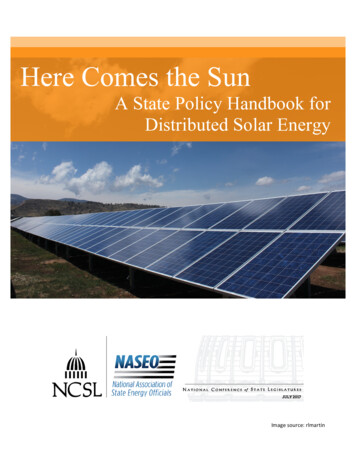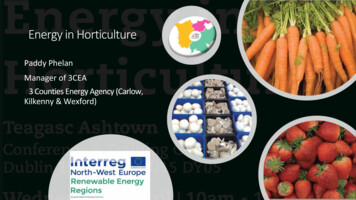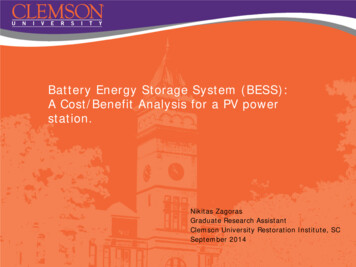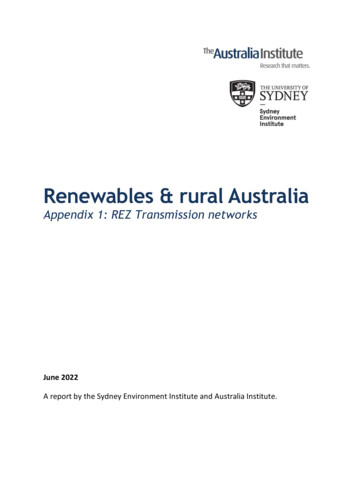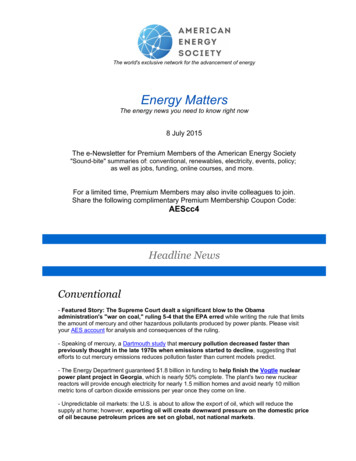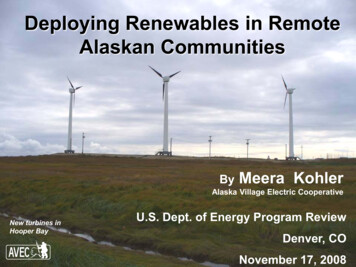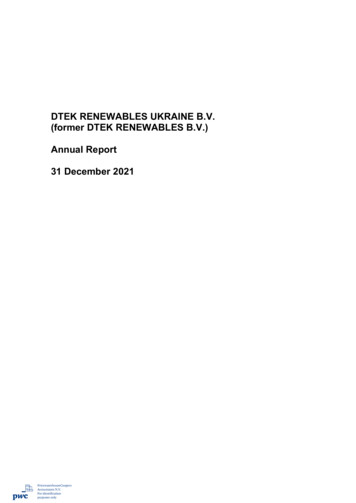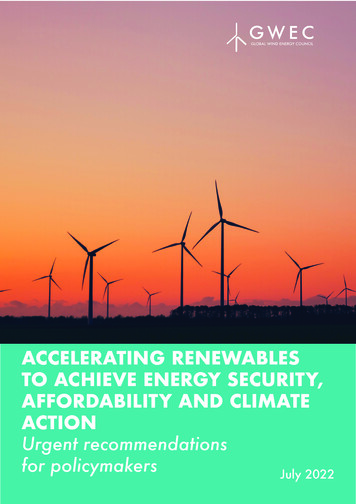
Transcription
ACCELERATING RENEWABLESTO ACHIEVE ENERGY SECURITY,AFFORDABILITY AND CLIMATEACTIONUrgent recommendationsfor policymakersJuly 2022
GWEC is a member-based organisation that represents the entire windenergy sector. The members of GWEC represent over 1,500 companies,organisations and institutions in more than 80 countries, includingmanufacturers, developers, component suppliers, research institutes, nationalwind and renewables associations, electricity providers, finance andinsurance companies.DisclaimerThis five point plan was approved by the Global Wind Energy Councilboard but does not reflect the views of all members.Report date: July 2022Joyce.Lee@GWEC.netAlex.Bath@GWEC.net
ACCELERATING RENEWABLES TO ACHIEVEENERGY SECURITY, AFFORDABILITY, AND CLIMATE ACTIONContextThe world is facing unprecedented challengesto energy security, rising inflation and anarrowing time window to achieve climategoals and limit dangerous global heating.The global crisis has worsened in the last12 months to constitute a true emergency,as consumers and industry face rocketingelectricity and energy bills and policymakersinitiate emergency response packages.Since the Russian invasion of Ukraine inFebruary 2022, oil and gas supply shockshave caused wholesale gas prices to soar tosix times higher than a year ago and crudeoil spot prices to spike by 66% ; fuel priceswhich are already at historic highs are forecastto continue climbing (see Annex: Crude oilprices versus natural gas spot prices from2019 to 2022).1 Due to gas price increases,households in Europe paid nearly two-thirdsmore for electricity in March 2022 comparedto December 2021, and they will face stillhigher bills once annual retail contracts runup.2The resulting inflation has reverberatedthroughout economies, and pushed inflationto its highest level in decades across the world(see Annex: Global commodity price changesfrom January 2020 to March 2022).3The current global energy crisis has revealedthe continued dangers of depending onfossil fuels. The crisis is a result of a delayedand disorderly energy transition. The onlypermanent fix for the three related problemsof security, affordability and climate change isa determined and accelerated effort to moveaway from fossil fuels to renewables andrelated enabling technologies.Wind energy is one of the most competitiveand quickly deployable technologies we havetoday, and has a central role in improvingglobal energy security. But for wind to thrive,it needs large volumes for deployment and arobust global supply chain – without these,any prospect of meeting net zero scenarios inthis decade is beyond reach.Some governments have already begunto enact change to increase volumes ofrenewable installations, as reflected in theREPowerEU framework to rapidly permitrenewable projects, the pledges at theLeaders’ Summit on offshore wind in the NorthSea and Vietnam’s preliminary target of 7-8GW of offshore wind by 2030.Despite these promising developments, theeffects of the current energy crisis will be withus for several years at least, while the effects ofthe climate crisis will remain much longer.However, we can take decisive actionswithin the next 12 months that will improvethe situation in the short to mid-term, whileavoiding decisions which lock in fossil fueldependency and risk worse crises in the future.There are five key steps to this plan:1 -4e5477b5ead4; -net-income-jumps-25high-oil-prices-2022-04-27/; ile/2 -power-prices-households-new-highs-2022-03-16/3 le/10986/37223/CMO-April-2022.pdf3
ACCELERATING RENEWABLES TO ACHIEVEENERGY SECURITY, AFFORDABILITY, AND CLIMATE ACTION1Urgently streamline permitting to produce a hugeincrease in wind capacity in the next 1-3 years andbuild a net zero-compatible project pipeline.This can be achieved while supporting harmonious co-existence of therenewables industry with other land and ocean users and balancing theinterests of many stakeholders. This is a clear “win-win” to lower energyprices, stimulate billions in investment, increase energy security andindependence, foster job creation and make progress on climate goals.2Implement a grid access action plan to get largevolumes of renewable energy connected.Parallel to scaling up wind and solar deployment, governments musturgently outline grid buildout plans which address grid connection, prioritydispatch, incentives for public/private investment and immediately scale upinfrastructure which can store, manage and deliver renewable energy.3Introduce simplified mechanisms for clean powerprocurement and pricing to rapidly unlock investment.Governments need to take concrete measures now to align market forceswith the policy objectives of the energy transition and accelerate the buildout of renewables projects and power infrastructure.4Avoid locking in large-scale fossil fuel-basedgeneration.It is vitally important that measures designed to respond to the currentcrisis in the short term do not lock in long-term fossil fuel subsidies andgeneration. This would only create stranded investments and assets whichare incompatible with long-term energy security, affordability and climategoals.5Commit to firm energy transition plans and milestonesto allow the renewables industry to plan for healthysupply chain development.Including proactive management of key commodities and materials andminimal trade barriers for green technologies.Further measures such as energy efficiency are also critical to responding to the current energysecurity crisis, as acknowledged in this wind industry response to the IEA’s 10-Point Plan toReduce the European Union’s Reliance on Russian Natural Gas.4
ACCELERATING RENEWABLES TO ACHIEVEENERGY SECURITY, AFFORDABILITY, AND CLIMATE ACTIONA Global Energy CrisisThe Russian invasion of Ukraine has exposed the starkest challenges of energy securityand fossil fuel dependence. But the energy crisis is global, and the past year has seenthe biggest disruption in the global energy market in modern times. We are witnessingpolicy and market misalignments in terms of achieving the energy transition, resolvingthe energy trilemma and delivering a green recovery in the wake of the COVID-19pandemic.Fossil fuel price volatility already caused turmoil through last year. Coal shortagesin China sparked widespread power outages and industrial shutdowns, while Indiaexperienced rolling outages due to low coal stockpiles and high coal prices.4 Theseevents were exacerbated by the intensifying impacts of climate change, includingdrought and recent heatwaves, as well as post-COVID industrial recovery that hassparked higher energydemand.At the same time, 2021 sawthe highest level of globalcarbon emissions in history,putting our Paris Agreementgoals at risk.5 The IPCC’slatest report has made it clearthat global greenhouse gasemissions must peak by 2025and halve by 2030 to limitglobal warming to 1.5 C.6But renewables buildout isnowhere near sufficient. Windenergy is growing in stopstart cycles in developingeconomies like South Africaand Mexico as well as maturemarkets in the West. Newwind and solar projects are4 runch-triggers-alarm-pleas-more-coal-2021-09-28/; ace-for-outages5 unded-to-their-highest-level-in-history-in-20216 /press-release/5
ACCELERATING RENEWABLES TO ACHIEVEENERGY SECURITY, AFFORDABILITY, AND CLIMATE ACTIONdenied access to grid, land or markets due to a lack of political will, overly lengthypermitting schemes or priority for incumbent fossil fuels.In 2021, onshore wind projects bid into auctions at levels 19% below global averageLCOE (Levelised Cost of Electricity), undercutting even the cheapest new fossil fuelgeneration.7 Yet as price pressure with regards to raw materials and transport continuesto increase, projects bids on scarce auction volumes keep declining, sometimes evenentering negative price territory.As a result of inadequate investment signals and restrictions on permitting, globalannual wind energy installations are only one-quarter of the level needed for a netzero trajectory.8Lagging growth in this decade leads to large wind energy shortfalls by 20307 c/Costs/Global-LCOE-and-Auction-values8 Wind energy installations are currently growing around 100 GW/year, but need to reach 390 GW of new wind capacity annually by 2030 inthe IEA Net Zero by 2050 Roadmap. This roadmap sets out a global electricity generation mix of wind (35%), solar (33%), hydropower (12%),nuclear (8%), bioenergy (5%), hydrogen-based (2%) and fossil fuels with carbon capture utilisation and storage (2%). The IRENA World EnergyTransitions Outlook: 1.5 C Pathway report sets out a similar global electricity mix of two-thirds wind and solar (comprising 8,174 GW of wind and14,878 GW of solar by 2050, with wind generating a slightly higher overall share of global electricity).6
ACCELERATING RENEWABLES TO ACHIEVEENERGY SECURITY, AFFORDABILITY, AND CLIMATE ACTIONNo Regret SolutionsFor The CrisisGWEC and its partners outline five key solutions below, which form both short-termresponses (next 1-3 years) to contribute to easing the energy supply crisis, as well aslong-term responses (to 2030) to scale up renewable energy worldwide. We havedesigned these solutions to be universal and flexible. This work has been informed byinternational experience, research and expert consultations with energy authorities,think tanks, consultancies and industry in 2022.We note that further solutions, such as energy efficiency measures (e.g. buildinginsulation, efficient heat pumps, behaviour change), widescale electrification andcarbon pricing mechanisms, will also be critical to an accelerated transition andrecovery from the current energy crisis.7
ACCELERATING RENEWABLES TO ACHIEVEENERGY SECURITY, AFFORDABILITY, AND CLIMATE ACTION1Urgently streamline permitting toproduce a huge increase in onshoreand offshore wind capacity in thenext 1-3 years and build a net zerocompatible project pipelineMassively scaling up utility-scale wind and solar energy is a clear “win-win” in termsof lowering energy prices, stimulating investment, economic growth and job creationand achieving climate targets while supporting energy security. It draws on limitless andindigenous energy resources, enabling countries to reduce dependency on importedfossil fuels and restore a healthier balance of trade. And it can be achieved whilesupporting harmonious co-existence of land and ocean users.While it is too late for wind and solar to address the coming winter spike in prices,large-scale renewables projects can be constructed very quickly once permitted –typically 1 year or less for onshore wind and solar and 2 years for offshore wind,depending on project size.Studies estimate there is a global pipeline of nearly 600 GW of wind projects indevelopment, of which many could be quickly constructed within the next 3 years underfast-track approval measures.9 If barriers in permitting, grid access and supply chainscale-up are resolved, these projects could materialise from end of 2023-2025 (seeAnnex: Average number of years for offshore wind lease award to full commissioning ofprojects).A majority of these identified “shovel-ready” wind projects are concentrated in the US,China, India, Australia, Brazil and the UK, where pipelines range from 25-100 GW ofcapacity. Further national pipelines of 10 GW of wind projects are identified withinthe EU27, while other countries with at least 5 GW in development include Mexico,Canada, South Korea, Japan, Turkey and South Africa.9 A clean COVID-19 recovery: The global opportunity 13,000 renewable energy projects for a green recovery. Prepared by EY-Parthenon, fundedby the European Climate Foundation; GWEC Market Intelligence.8
ACCELERATING RENEWABLES TO ACHIEVEENERGY SECURITY, AFFORDABILITY, AND CLIMATE ACTIONTo put this into perspective, just 5 GW of onshore wind development generatesroughly:10 US 14 billion investment (US 35 billion for offshore wind projects) 130,000 jobs during the development, construction and installation phase ofprojects, and then a further 12,000 local jobs per year during the 25-year projectlifetime Enough renewable electricity to power 4.9 million homes with clean energy peryear Savings of 28.8 million litres of water annually, otherwise used for thermalCapturing just one-quarter of these identified “shovel-ready” project opportunitiesacross the EU27, G7 and G20 could realise annual wind energy installations of 200GW by 2025 – double what we are installing today, and far closer to where we needto be for a net zero-compatible pathway.11Global annual wind installations in Business-As-Usual vs Accelerated Scenarios, GWThe COVID-19 experience has shown that robust physical and digital infrastructure canbe assembled in a crisis to reorganise supply chains in line with national interests. Thesame urgency needs to apply to the energy sector, with priority to building renewableprojects and enabling infrastructure.10 Capturing green recovery opportunities from wind power in developing economies, GWEC, February 2022.11 The IEA’s Net Zero by 2050 Roadmap (2021) targets 390 GW of wind installations by 2030 for a 1.5 C and net zero-compliant pathway. Giventhe 104 GW installed in 2020, an incremental ramp-up sees around 220 GW of wind installed in 2025 to reach the net zero scenario. GWECMarket Intelligence forecasts 120 GW installed in 2025 in a BAU scenario.9
ACCELERATING RENEWABLES TO ACHIEVEENERGY SECURITY, AFFORDABILITY, AND CLIMATE ACTIONGWEC recommends the following measures to streamline permitting for wind energyprojects:I.Assess “shovel-ready” onshore and offshore wind projects within nationaljurisdictions, identifying those which can be green-lit for construction within thenext 1-3 years.II.Mandate maximum lead times to permit wind plants. Standard recommendedlead times are 2 years for greenfield onshore wind projects, 3 years for offshorewind projects and 1 year for repowering projects – these could be halved inlight of the current energy supply crisis.III. Dedicate centralised authorities and single focal points to work with renewabledevelopers to streamline the siting and permitting process, such as through a“one-stop shop” model.IV. Invest in more staff and digital resources for the various authorities which makedecisions during the permitting process of a renewable energy and infrastructureproject.V.Build digitised, searchable and up-to-date databases for land registrations andsiting of renewable energy projects, including an inventory of local ordinancesand records of where energy projects have met community resistance, whichcan support zoning for projects.VI. Align land and ocean use guidance at national and sub-national level,prioritising projects which support energy security, “Do No Significant Harm”principles, minimal impact to biodiversity and the green economy. This shouldalso include designation of promotional “go-to” zones for new renewableenergy projects to spur future development, and a review of minimum distancerequirements which are up-to-date with latest technologies.VII. Promote active dialogues between local authorities, communities and industry toensure a shared understanding of priorities and concerns during the consentingand construction stages of wind projects. This is important to ensure a balanceof interests across stakeholders and harmonious co-existence of the renewablesindustry with other land/ocean users.VIII. Policymakers can consider attaching community benefit schemes to renewablesprojects to improve public support.IX. Implement an emergency clearing house mechanism for legal disputes toprevent extended delays to critical infrastructure projects, and a structured andtime-limited process for developers to provide evidence.X.10Enable repowering via regulatory fast-tracks covering EIA procedures, gridexpansion and site license extensions, allowing new turbine technology toexpand generation at existing sites.
ACCELERATING RENEWABLES TO ACHIEVEENERGY SECURITY, AFFORDABILITY, AND CLIMATE ACTION2Implement a grid accessaction plan to get largevolumes of renewableenergy connectedLess than 30% of public and private energy investment today targets storage and gridmanagement solutions, and this needs to step up.12 In many countries renewablesprojects face delays in connecting to the grid, and thermal plants retain priority griddispatch. Without increasing grid, storage and flexibility services buildout, ramping uputility-scale renewables and electrification could drive up the costs of system balancingand redispatch. This could lead to curtailment issues and increased transmission anddistribution levies for end-users.Long-term anticipatory investments in grid, storage and flexibility services will resultin huge competitive advantage and public savings. For example, the IEA showsthat capital investment for clean energy technologies (wind, solar, batteries andelectrolysers) in India to 2040, in line with a net zero pathway, would require US 1.4trillion in additional funding compared to a business-as-usual scenario – but this amountwould be more than recovered by the savings from oil import bills.13We therefore call on governments to urgently:In the short termI. Conduct a review of lead times for grid connection decisions, and establish amandated maximum lead time to ensure renewable projects can access timelyconnection to the grid. This can include a locational approach to siting andleasing allocation of new renewable energy projects, in zones which are underless pressure of grid congestion or constraint.II. Establish a merit order for generation while assigning priority dispatch torenewables projects (if not already granted in liberalised markets with marginalcost-based dispatch). Increase the flexibility requirements for remaining fossilgeneration.12 -tide-of-green-capital13 02111
ACCELERATING RENEWABLES TO ACHIEVEENERGY SECURITY, AFFORDABILITY, AND CLIMATE ACTIONIII. Establish adequately resourced energy transition infrastructure commissions withstrong mandates and powers. Such commissions can work closely with systemoperators and distribution authorities to harmonise grid planning needs and fostergrid/cyber security.In the mid termIV. Ensure that investable frameworks for grid and flexibility services on supply anddemand side are in place to allow adequate capital investment from the privatesector, multilateral agencies and public bodies. Remove bottlenecks for publicfinancing of grids in countries where this applies, e.g. allow for earlier orders ofequipment by grid operators.V. Align decision-making across sectors with indicative planning for grids,renewables and industry. Special public-private taskforces or working groupsshould combine representatives of different sectors and constituency groups,including industry, to ensure harmonisation of emissions thresholds and targets forenergy demand and supply.VI. Increase multilateral collaboration for equitable cross-border power trading,while ensuring diversity of supply and appropriate levels of spare capacity.12
ACCELERATING RENEWABLES TO ACHIEVEENERGY SECURITY, AFFORDABILITY, AND CLIMATE ACTION3Introduce a simplifiedmechanism for cleanpower pricing to rapidlyunlock investmentThe energy sector is highly politicised with net zero ambitions and capacity targets, andthere is a great deal of global capital waiting to flow into onshore and offshore windprojects. But energy policy and energy markets are not coherent – electricity marketsstruggle to send meaningful and timely investment signals to enact the transition.14If fossil fuel prices fall back to pre-crisis levels in the next few years, renewablegenerators will again be subject to the cannibalisation effect, with near-zero marginalcosts of an increasing number of wind and solar plants pushing clearing pricesdownward during periods of high generation.Some markets are in a healthier state than others. But in many places, wholesalemarket design and the cannibalisation effect are leading to insufficient remuneration togenerators to provide the massive working capital needed to invest upfront in new highCAPEX utility-scale wind and solar projects – let alone in further technology innovationand R&D needs. This challenge is further underscored by the prospect of rising inflationand interest rates.While auctions have grown in popularity, in many countries they work like a faucetrunning on a stop-start basis, often with restricted volume. Auctions that aim toleverage wholesale markets and achieve “negative bidding” (where the industrypays governments for the right to build a wind farm) have been particularly unhelpful,undermining the viability of renewables to replace fossil fuels.The organisational structure of power markets must evolve to incentivise investment in14 Wholesale markets based on marginal costs fulfil their design objective by allowing for cost-efficient power dispatch, when thermal plants areflexible enough to react to price signals. But this market design, introduced in many regions in the 1990s during market liberalisation, fails to sufficiently incentivise investment in low-marginal cost renewable generation.13
ACCELERATING RENEWABLES TO ACHIEVEENERGY SECURITY, AFFORDABILITY, AND CLIMATE ACTIONlow-marginal cost, high-CAPEX renewable generation and power infrastructure, aswell as the optimal operation of these assets. But we recognise that such reforms arecomplex and time-consuming, and governments need to take concrete measures nowto ensure green electrons are available.In the short termI. Launch an emergency national RFP/Open Call for renewable energyproject development proposals, with long-term offtake contracts. A simpleand transparent price mechanism should reasonably balance between costefficient power supply, revenue stabilisation, risk-sharing between offtakersand generators and healthy supply chain development. It should be based onrequired levels of CAPEX investment, social and environmental value and viablerates of return. It is important for CAPEX calculations to be indexed to pricesfor key commodities required for the wind and solar supply chain, revised on aregular basis.II. Move away from restricted and stop-start procurement schemes, and implementmechanisms for continuous procurement based on rolling supply of contractswith government and stable annual capacity targets for the next decade, whichcan spur large-scale project development and a business case for supply chaininvestment.15In the mid termIII. Governments should consider the shift in power procurement targets from a“lowest cost” basis to a “highest value for money” approach, given priceuncertainty has a far-reaching impact on inflation and economic planning. Thereis a false narrative of continually falling costs in utility-scale wind and solarenergy. While these technologies will continue to out-compete fossil fuels inwholesale markets, supply-side pressures and commodity/freight difficulties arefundamental business challenges and current design of liberalised power marketsundermines the revenue case for renewables.III. Adapt energy markets for high shares of renewable energy, new forms offlexibility and demand (such as green hydrogen and storage) and a broaderreflection of socioeconomic and system value of power generation.16 GWECand its partners are supportive of a mid-term initiative to map out power marketevolution for the energy transition with cross-sectoral industry input, includingrecommendations for different regions and countries, building on the existingbody of work on this topic.15 Such recommendations have been made by leading bodies like IRENA already, such as in a “dual market” approach that would see annualauctions for long-term contracts driving the energy market and addressing the requirements of CAPEX-intensive technologies, while a paralleldelivery market procures and affordably dispatches the flexible resources for a power system. See: Power-system-structures; -consultation-paper-210316.pdf.16 It is critical to ensure electricity market design supports large-scale renewables deployment, increased flexibility and storage. Otherwise, theIEA’s Net Zero by 2050 Roadmap finds that by 2050, around 7% of wind and solar output would need to be curtailed, while major markets wouldsee share of “zero-price” hours in the year rising from near-zero to 30%.14
ACCELERATING RENEWABLES TO ACHIEVEENERGY SECURITY, AFFORDABILITY, AND CLIMATE ACTION4Avoid locking in large-scalefossil fuel-based generationfor decades to comeGovernments will need to take immediate measures to diversify fossil-based energysupply where they can. However, policymakers must be clear-eyed: Many solutionsbeing proposed as urgent fixes will in fact take several years to implement (e.g. sitingand construction of new LNG storage terminals, large-scale fracking, secondary oiland gas production in depleted provinces).17 As much as possible, the speed andefficiency of constructing new grid-scale wind energy projects must be recognised, andprioritised for investment over further fossil fuel infrastructure.Offering affordability, scalability, clean power and strong capacity factors, windenergy is already set to displace fossil fuel generation in economies worldwide, albeitnot at a pace which is compatible with net zero (see Annex: Wind energy is set todisplace gas in advanced and developing economies). This trend should be acceleratedand not weakened in light of the current crisis.We therefore call on governments to urgently implement the following measures:I. Take emergency measures to increase energy efficiency and reduce demand forfossil fuels, particularly in hard to abate sectors such as gas-based heating.II. Take measures to stabilise supply and diversify fossil fuel supply to increaseenergy security, especially in Europe where an exit from Russian fossil fuels mustbe achieved.III. Recognise the full lifecycle of greenhouse gas emissions, including CO2 andmethane, of fossil fuel generation like coal, oil and gas, and the costs of theseexternalities to health and the environment. Ensure fossil fuels are taxed throughcarbon pricing mechanisms.17 As the World Bank notes on the current energy crisis, “well-intentioned energy subsidies could delay the transition to a zero-carbon economy.”See: le/10986/37223/CMO-April-2022.pdf.15
ACCELERATING RENEWABLES TO ACHIEVEENERGY SECURITY, AFFORDABILITY, AND CLIMATE ACTIONIV. Earmark the proceeds of carbon pricing mechanisms for investment in grid,storage and flexibility services to provide a strong foundation for a renewablesbased system.V. Ensure that new direct and indirect subsidies are not introduced for fossil fuelproduction and generation. Such a measure could be adopted among theG7/G20 or intergovernmental bodies like IRENA and the IEA, where membercountries can agree to reduce demand and new investment in fossil fuels, ashappened after the oil price shock of 1979.VI. Ensure that investments are not directed to fossil fuel infrastructure which will makelittle difference to the current energy crisis. This includes refining green taxonomyframeworks for sustainable finance and ensuring that investment signals in thecurrent crisis are not directed towards new fossil fuels and new nuclear projectswhich prolong the transition, further expose countries to fuel and price volatilityand result in stranded assets.16
ACCELERATING RENEWABLES TO ACHIEVEENERGY SECURITY, AFFORDABILITY, AND CLIMATE ACTION5Commit to firm energy transitionplans and milestones to allow therenewables industry to plan forhealthy supply chain developmentThe past year has shown the exposure and vulnerability of key renewables industriesto geopolitical dependencies, commodity price cycles, logistics bottlenecks and tradebarriers. The sudden post-lockdown recovery of industrial production last year led tofierce competition among different industries for raw materials, as well as ongoingbottlenecks in manufacturing capacity and transport logistics such as shipping (seeAnnex: Global metals price changes from 2019 to 2022).This has had a significant impact on the wind industry as procurement and freight forraw materials and commodities of wind turbines, including steel, concrete, copper,nickel and a small but high-value volume of rare earth elements (REE) make up the lion’sshare of wind project CAPEX.There has been a clear misalignment between energy, industrial, trade and financialpolicies. It must be understood that without well-functioning and competitive industrialsupply chains and access to raw materials and components, there is no energytransition.We therefore call on governments to urgently implement the following measures:17
ACCELERATING RENEWABLES TO ACHIEVEENERGY SECURITY, AFFORDABILITY, AND CLIMATE ACTIONI. Cooperate via international forums, such as IRENA, IEA and WEF, as wellas financial institutions to create a global index of key commodities for therenewable energy transition.II. Create a new multi-stakeholder global body or special commission forcoordinating stockpiles an
that global greenhouse gas emissions must peak by 2025 and halve by 2030 to limit global warming to 1.5 C.6 But renewables buildout is nowhere near sufficient. Wind energy is growing in stop-start cycles in developing economies like South Africa and Mexico as well as mature markets in the West. New wind and solar projects are A Global Energy .
